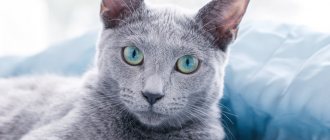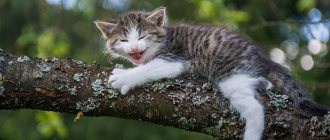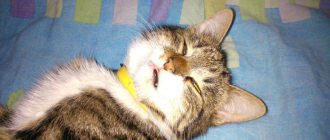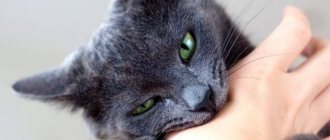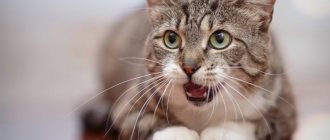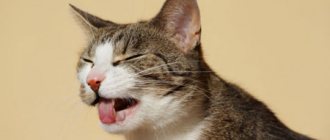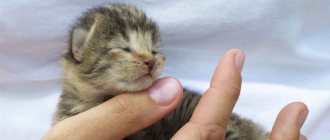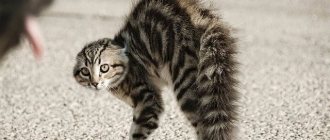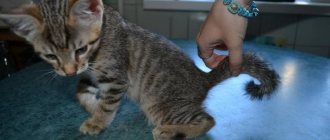Why is the cat thin and not getting fat?
The normal weight of a cat is between 3.5 and 5 kg.
It all depends on the breed. Cats of different origins differ in activity, dynamics and metabolism. In adulthood, the individual reaches 7-8 kg. You can find out why a cat doesn’t get fat if you understand how nutrition affects your pet’s body. When a cat is thin and does not gain weight, but eats a lot, this does not mean that the pet is sick. If an animal spends its days running and jumping around the apartment or on the street, losing weight and not gaining weight becomes a good sign. The body consumes the energy received from food, the digestive system develops and functions in a stable manner.
Other reasons for losing weight include:
- A cat cannot gain weight after giving birth . If there are more than 2 kittens in the litter, you should not count on rapid weight restoration. Carrying out such a brood takes a lot of effort and energy. Therefore, mother cats will need time.
- Males begin to lose weight during the period of sexual heat, as do females . In spring, the body of cats and dogs is especially active. Castration will help: sterilized cats simply have nothing to do, so such animals gain weight instantly.
- Pets are not adapted to stressful situations and therefore do not gain weight . Street cats are constantly under threat. An uninvited guest, a new pet in the apartment, or even a newborn baby can shock a furry animal. Refusal to eat is a natural reaction.
- If the cat eats well and does not get better, the problem may be a helminthic infestation . Helminths enter the body through the dirty hands of the owners, an unwashed tray, and dirty water. It is better to start treatment immediately: the period of getting rid of worms can last up to six months.
- It is useless to feed old cats heavily . With age, the activity of females and males decreases. Cats spend more and more time lying down and moving little. This does not indicate illness: the cat will not eat more than the body needs.
- Vitamin deficiency leads to weight loss . Industrial feed will correct the situation. Artificial formulations (available in dry and liquid forms) contain mineral supplements and restore the balance of beneficial components in the body.
When should you not panic?
An animal's activity is the best evidence of health. A cat that constantly plays, runs, sleeps little and constantly asks for food is not at risk and periodically loses weight. The morning amount of food is burned in a matter of hours and therefore in the afternoon the pet will ask for more. But you should not overfeed your cat.
Old cats are already losing interest in games, losing weight, and it’s not a matter of illness. With age, the cat moves and studies less and less, and observes and evaluates more often. The fewer movements, the less energy is burned, and, accordingly, the minimum amount of food will be needed.
Mild poisoning for cats is a common situation, especially if the pet eats the same food as the owner. Diarrhea for two to three days does not indicate a serious illness. If the problem persists for more than a week, it is wise to contact a specialist.
When to sound the alarm
It is risky to specifically fatten animals if they are not getting fat. Probably, a cat, by its breed, cannot be fat or thin. The weight of Maine Coons can reach 10 kg, and yard cats, as a rule, always remain “slender”. In order for a cat to get better, the diet changes, but the characteristics of the breed and the individual parameters of the body are first studied.
You should contact your veterinarian if:
- The cat refuses food for a long time. If the animal does not gain weight, it may be due to dental disease, which can lead to a complete loss of appetite.
- Unpleasant smell. Pathologies of the gastrointestinal tract lead not only to the fact that the cat does not gain weight, but also affects the internal organs. Doctors will check your kidneys, intestines and liver.
- The animal behaves apathetically. Health problems are indicated by lethargy and sudden activity, prolonged drowsiness. This is not typical for kittens and young individuals.
- The cat has diarrhea and constant vomiting. Mild poisoning lasts no more than 2-3 days. A stomach disease is indicated by the fact that the cat does not gain weight for a long time, and meals are accompanied by vomit and loose stools.
A cat does not get fat if its diet is constantly changing. For a pet, unlike a person, monotony is optimal. This is natural food or industrial, artificially produced and offered in finished form.
Purchasing ready-made formulations from pharmacies is a priority. This is a guarantee that the food meets its production date and expiration date, is certified and has passed medical tests. If the cat does not gain weight due to illness, you can buy special medicated food.
Why does a cat need grass?
An indispensable ingredient in the diet of a cat that is losing weight is green grass. This is a natural food that has a positive effect on the functioning of the digestive system. The grass contains zinc, manganese, pantothenic acid and vitamins of various groups, which are necessary to rid the body of parasites and strengthen the immune system.
Constantly monitoring the weight and whether the cat is losing weight or getting fat is the right decision. This is an indicator of the development of the body, the appearance of symptoms of diseases and other problems. A well-formulated diet will help protect an adult cat and keep a kitten safe.
Fattening a cat if it is losing weight is deliberately dangerous. A fat and fluffy animal looks cute and even adorable, but for the animal it is an extra burden, decreased activity and the risk of various diseases that occur in a passive form and may not be noticeable at the initial stage.
Source
Determining the norm
Before we understand what to do, let's understand what a skinny Scottish cat or skinny Scottish cat is. Many owners suffer that their animal is not fat enough, although, in fact, its weight is within the normal range. So first, check out the normal weight chart for a Scottish cat. Of course, you need to pay attention not only to weight, but also to height: what is a lot for one animal, is not enough for another. But the general rule is this: if a cat’s pelvic bones and ribs are visible, you should sound the alarm and solve the problem urgently.
Well, now let's look at the main reasons why the Scottish cat is thin.
Dangerous and safe symptoms
You shouldn’t worry when your cat is thinner if he has:
- a certain breed - Bengal, Somali, Abyssinian;
- active lifestyle;
- age more than 10 years;
- change of lifestyle (moving, new litter box, new owner).
If the pet is in a calm state, but is suddenly losing weight, then the symptoms of the disease may be:
- drowsiness;
- At first the cat led an active life, then suddenly became lethargic and apathetic;
- loss of a large amount of hair;
- blood in excrement;
- nausea, constipation or diarrhea;
- heat;
- blanching of the mucous membranes.
- medicines;
- vitamin supplements;
- change of diet;
- change of activity mode.
When wondering why a cat is thin, and whether this is normal, factors such as normal and painful thinness are taken into account. In the first case, we are talking about the weight standard that an animal of a particular breed must meet at a certain age. The second is about exhaustion. A cat that is too thin is most likely sick and requires long-term rehabilitation therapy, which can only be prescribed by a specialist.
Appearance standards for British breeds
Genetic miniature
Experienced breeders build genetic lines so that one of the main characteristics of the breed - resemblance to a teddy bear - is well developed. Thin and scrawny cats are removed from breeding.
The situation is different with pets that are bred without permission, pedigree or prior training of the owner. Suppose the cat was not bought for breeding, she grew up miniature and could be an excellent pet, but the owners decided to make money from her by selling kittens. Such a mommy or such a daddy will pass on their small genes to their children. If this is the case and you see that the cat is not so much thin as it is miniature, there’s nothing you can do about it: genes take their toll.
Unbalanced diet
No matter how trivial, but most often the reason for the thinness of a Scottish cat is poor nutrition. The cat does not receive enough vitamins and microelements, as well as protein, and therefore muscle and fat mass are insufficient. Let us remind you that cats must receive meat and protein daily in an amount of at least 70-80% of the diet, and preferably 90%. It is from meat that the cat receives most of the nutrients the body needs.
And under no circumstances should you stuff it exclusively with pasta and vegetables, adding only a little meat. However, pasta and cereals, even in small quantities, often lead to the kitten not gaining weight: most cats do not have a good relationship with grains (cereals interfere with the absorption of nutrients from other foods), so it is better to exclude them from the diet.
Often the problem of unbalanced nutrition is low-quality ready-made factory feed: this is the majority of feed that is sold in supermarkets. If you give your cat food, it should only be premium and super premium. Although, it is worth noting that often good premium food is simply not suitable for a kitten, as a result of which it does not gain weight.
“We had a weak, thin, fold-eared kitten. We adopted him when he was 3 months old; before that he lived in a nursery with a professional breeder, i.e. There shouldn't be any problems. His brothers and sisters were also not very plump, but this one was completely thin and weak. At 3 months I weighed 1 kg! In the nursery he was fed on Royal Canin. My animals are all natural, so in any case we planned to switch him to meat. I generally have a bad attitude towards food. But, on the other hand, I understand that cats have been growing up on Royal for generations - and everything is fine with them. Therefore, I think that the reason was that this particular cat’s body did not accept this food, and perhaps it would not have accepted other foods either. He ate normal portions, but was skin and bones. In general, in the very first days we switched him to raw meat. More precisely, he transferred himself by stealing food from an adult cat. And what do you think? After 2 weeks he already weighed 1.5 kg. The rate of weight gain, of course, is too high, but it turned out how it turned out. At 4 months it was already 2.5 kg, at 5 months - 3.2 kg. Matured. He became well-fed. No protruding ribs or spine. This is how proper nutrition works wonders,” says Ekaterina, the owner of a Highland Fold cat.
How to feed a cat correctly?
If the cat has lost a lot of weight, the owner may have incorrectly compiled the daily diet and menu for the pet. There are a number of rules thanks to which you can maintain a stable weight of the animal and protect your family pet from threats:
It is important to choose only one food option, otherwise the cat will not only lose weight, but may also get sick. This is a branded industrial feed or natural food. You can find branded food by the labels holistic, premium and supreme. These are classes that confirm compliance with high production standards.
Do not mix natural food and industrial feed. A cat develops one type of digestion, aimed at “artificial” or natural food. Your cat will need more moisture to digest the crackers. With constant changes in diet, the digestive system cannot adapt in a timely manner, which is why the stomach and intestines suffer.
Don't trust advertising. The brand names Whiskas and Kitiket, which have already become household names, do not become a sign of quality . These are affordable feeds to which attractive agents are mixed. These are components that act like a drug and are addictive. This is a serious burden for a pet’s gastrointestinal tract. A cat will live a long time if you feed it food that is sold in specialized stores, and not on supermarket displays.
Low appetite
Do you offer your cat good food, but she still doesn't eat well? There are different reasons for poor appetite. These are worms, which will be discussed below. This is also stress. This includes teething. These are behavioral problems: read about them here.
But most often, poor appetite is observed in uncastrated cats and unsterilized cats during rutting periods: then the desire to eat fades into the background or may practically disappear. And if estrus is frequent or the cat’s sexual desire is not systematically satisfied, then the endless rut can exhaust the body. If you plan to castrate an animal, then after the operation (about 1 month) the pet’s body will be rebuilt - and its appetite will become excellent.
Is a cat thin or plump - how to determine the norm?
For purebred purrs, a standard is prescribed, which provides detailed characteristics of the mustache and the boundaries of the minimum and maximum body weight, as well as height. If you are the happy owner of a mongrel or yard pet, then you will need to carefully examine and palpate your favorite creature:
- Position your pet so that the front legs are level and the hind legs are at a slight angle, moving more towards the tail.
- Feel the antennae's ribs and spine. If the spine is smooth without excessive convexities and only the outer ribs are felt to the touch, then this is normal.
- Feel the pelvic area - the croup should be smooth, and the joint bones should not protrude much.
- It is considered normal if the pet’s belly sags a little or is tucked up. When moving, a fold appears in the abdominal area.
- If a slight layer of fat is felt on the chest and abdomen, then this is quite normal.
- In the cold season, there may also be small layers of fat on the sides and this is good.
If you clearly see protruding ribs, pelvic bones, spine, a large depression in the peritoneum, and in the area of the forearms, chest and hind limbs the muscles seem to be hanging down, then the cat is clearly underweight.
Many owners believe that their fluffies are too thin, but it is important to understand that some breeds are characterized by such a constitution. These mustaches usually have a good muscular corset and a good appetite.
It is important to understand that all mustaches are individual and you should not compare your favorite with your neighbor’s.
Physiological causes of weight loss
- Presence of offspring. If the pet has become a nursing mother, then she will have a strong appetite, but at the same time she may lose weight, especially if there were a lot of babies in lambing. After finishing feeding, mommy will immediately begin to recover.
- Anxiety. When a change of residence occurs or a pet does not see its owners for a long time, it experiences stress, which can affect its body weight, even if it eats well.
- Mating season. This point especially applies to those mustaches who have access to the street. In the spring, when they are looking for a mate, there is a big waste of energy and the fluffies in love lose weight.
- Hunger and change of usual food. If for some reason your pet is starving, then she will certainly lose weight, but a change in food can also affect her weight. Very often, when switching from a natural diet to commercial food, fluffies begin to lose weight because they do not accept the new food. In this case, there is no need to rush - do everything gradually and add food in small portions to the overall diet. When switching to another food that is unusual for the animal, be sure to monitor its weight.
- Age. Older pets lead a less active lifestyle, eat less and, as a result, lose weight (here it is important to exclude age-related cat diseases from a veterinarian).
Health problems as a cause of weight loss
- Dysbacteriosis. Some pets have metabolic problems from birth, while others suffer from it due to poor quality nutrition. In such a situation, it is necessary to adjust the cat’s menu and add vitamins and probiotics to it. The doctor will help you determine which probiotics your mustache needs after passing the tests.
- Presence of microparasites. Deworming needs to be done regularly.
- Dental problems. Inflammatory processes in the gums and tartar cause discomfort and the cat (even a hungry one) refuses treats. Here you need the help of a specialist.
- Oncology. Neoplasms in internal organs have a bad effect on a cat's health. If you don’t understand why your domestic cat is thin and not getting better, then first of all rule out the presence of tumors and do an ultrasound.
- Presence of internal diseases and infections. In addition to emaciation, your pet may experience other symptoms: vomiting, fever, change in stool, refusal of treats, etc. - all this signals some kind of pathology (disease of the gastrointestinal tract, liver, kidneys, etc.). At the same time, the cat may have “caught” an infection - panleukopenia, viral hepatitis, etc. Timely diagnosis is necessary here. Curing the disease will lead to weight gain.
What is the optimal weight for an adult cat?
Depending on the breed, the pet’s weight varies from 3 to 7 kg. Mature animals are usually fit and lean, especially if it is a male, who is losing weight and gaining weight constantly. The lifestyle of a healthy cat is active and dynamic. After “playing”, the pet wants to drink a lot, the animal eats abundantly, which has a positive effect on the digestive processes.
Dangerous symptoms of weight loss include:
- Lethargy, apathy . Sudden mood changes are evidence of anxiety. The cat feels bad and cannot find a place for itself, does not play and refuses food.
- Blood, frequent diarrhea . If the cat has lost weight and foreign inclusions are observed in the urine and diarrhea, you need to go to the clinic and have tests done.
- Bloating . Do not confuse high weight with a bloated stomach. The cat may become worse and worse due to internal swelling, infection, infection, which is why he does not eat.
How to help your pet get better?
If the cause of weight loss is a disease, then it should be treated under the supervision of specialists. In other cases, a selection of high-energy foods can help, which will help build muscle and a small layer of fat.
- Beef meat.
- Boiled liver (beef, chicken).
- Chicken yolk – 2 times a week.
- Boiled oatmeal.
- Cartilage jelly.
- Low-fat cottage cheese and yogurt.
- Energy supplements from the pet store - drops, pills, powders.
Healthy cat diet
The owners themselves are often to blame for pets having weight problems. Often people overfeed their pets, leading to obesity, or, on the contrary, give them insufficient food. A common mistake breeders make is feeding unbalanced or low-quality food.
Fortunately, the problem of malnutrition can be easily eliminated at home by taking care of a healthy menu for your pet.
What to do if your cat is thin but eats well? It is necessary to include in her diet the products necessary for normal life. First of all, you need to remember that cats are carnivores and their menu should consist of 50% meat products. The pet should also drink well, so there should always be fresh, clean water in the bowl.
If the cat is thin, his diet must include::
- lean boiled meat (beef, chicken, turkey);
- vegetables (carrots, pumpkin, spinach);
- cereals (buckwheat, oatmeal, rice);
- liver (beef, chicken);
- dairy products (natural yoghurt, cottage cheese);
- boiled fatty fish (herring, sardine, mackerel, salmon).
Special vitamin complexes and dietary supplements will also help correct the situation. And if the cat eats ready-made food, then among the premium items there will definitely be a high-energy type that can solve the problem.
Skinny cat, or why the cat doesn't get better
Owners often come to veterinarians with one question: why is the cat so thin? An animal can eat well, but at the same time either noticeably lose body weight or remain underweight, from the point of view of the owners.
The ideal body weight of an animal depends on the breed, gender and age. While for purebred cats it is possible to find out approximate weight parameters, for outbred cats this is quite difficult, so the proportions of the pet and the approximate ratio of muscle and fat mass are more often assessed.
Why is a cat losing weight?
Pathology
If a cat eats a lot of food, but loses weight, there are several reasons:
- Presence of parasites . Worms or helminths can destroy a pet’s body from the inside. Even though the cat eats a lot of food, he continues to lose weight. A cat can become infected with helminths through dirty shoes, unwashed hands, or a dirty litter tray. You can get rid of parasites only by using special medications (treatment is carried out for at least six months).
- Diseases of internal organs. In diseases, there are two mechanisms for losing weight: lack of appetite and small doses of food consumed; and the process of digestion and absorption of food is disrupted. Endocrine diseases and pathologies of the digestive system lead to weight loss even when eating enough food. Associated symptoms are apathy, hair loss, diarrhea or constipation, etc.
- Stress. If an animal is stressed for a long time, it may lose weight even with a good appetite. If a cat is depressed, there may be no appetite at all, which also affects weight. Well, you need to wait for the cat to return to normal; neurological disorders require treatment and sedative medications.
- Infections. Infectious diseases are always accompanied by weight loss. All because the pet refuses food and water. The most common diseases are calcivirosis, rhinotracheitis, viral peritonitis, and panleukopenia. Often these diseases lead to the death of the pet.
- Tumors. Any malignant neoplasms can cause exhaustion in a cat. The animal has no appetite, hair falls out, and vomiting and diarrhea are possible.
- Allergy. If there is an allergic reaction, the cat may lose its sense of smell, making it difficult for it to perceive food. She will eat less and lose weight.
We recommend reading: Can lichen be transmitted to humans from a cow?
Don't forget about vaccinations. Most people believe that if an animal lives in a house, it cannot get sick. We can bring various viruses and infections with clothes or shoes, and cats living at home are more susceptible to them than street cats.
Physiological reasons
The conditions in which the animal is kept also matters. Here the reasons for weight loss can be:
- Mating period. During this time, pets may forget about food and lose body weight. At the end of the period of “festivities” the animal returns to normal. Changes in temperature. In winter, the cat accumulates fat; in summer, the fat is absorbed.
- Pregnancy . During pregnancy, a cat's appetite is always good, but as soon as she starts feeding kittens, she may lose weight. Everything will fall into place as soon as the feeding period is over.
- Feed. A cat's weight directly depends on the quality of food consumed. You cannot suddenly change her diet from dry food to homemade food. Due to menu changes, the pet always loses weight.
Most owners do not check the weight standards for their pet, taking into account its age and breed.
A very thin cat: signs of exhaustion
Weight loss in pets remains invisible to owners until a certain time, especially if the cat is covered with long hair. Some active animals maintain a slim figure for the rest of their lives, so it is important to understand the difference between physiological moderate thinness, or, as they say, leanness (when the animal has a small layer of subcutaneous fatty tissue) and a pathological condition.
Normal thinness
For example, many owners are concerned about why a neutered cat is thin and not gaining weight. However, in most cases, there is no reason to worry, there is simply a myth that after castration the animal must certainly gain weight, and if it remains the same weight, then this is a sign of illness.
Normally, a cat's waist is clearly visible. The ribs and pelvic bones are not externally distinguishable, but they are easy to feel. You can feel a thin layer of fat under the skin of the chest and abdomen with your fingers.
When is it time to sound the alarm?
When an animal is severely exhausted and dehydrated, they speak of cachexia - a state of extreme exhaustion of the body. A cat with cachexia has thin limbs, the fur becomes dull and disheveled, the stomach is retracted, the ribs and protrusions of the pelvic bones are clearly visible.
The fat layer in the chest area is very thin or cannot be felt at all, and is absent in the abdominal area. In this condition, the muscles atrophy, the pet becomes less energetic, and sometimes the weakness is so severe that the cat is not able to cope with its physiological needs in the usual way.
Cachexia can develop gradually, over a long time, or rapidly - it all depends on the disease that caused it.
Possible causes of exhaustion
Because of its occurrence, cachexia is usually divided into exogenous (arising under the influence of external factors) and endogenous (appearing due to internal changes in the functioning of the body). Exogenous depletion includes those options when the animal simply does not receive enough food due to poor feeding or impaired swallowing.
Endogenous cachexia develops in various severe diseases of an infectious or non-infectious nature and may indicate the onset of terminal (extremely dangerous, life-threatening) stages of the disease.
Most often, cachexia accompanies the following pathologies:
- oncology;
- heart diseases;
- liver or kidney failure;
- hormonal disorders (for example, excess production of thyroid hormones);
- diabetes;
- inflammation of the pancreas;
- dysfunction of the pituitary gland;
- viral diseases;
- helminth infestations;
- chronic infections (leukemia, infectious peritonitis, immunodeficiency of cats);
- disruption of enzyme production.
The thinness of an animal caused by any disease is not necessarily accompanied by anorexia - refusal to feed. The animal may maintain its appetite, even consume more food than before, but continue to lose weight. The same applies to thirst: even increased fluid intake does not prevent dehydration in an exhausted animal.
Causes of thinness
Veterinarians divide the reasons for cat thinness into two types!
Skinny, emaciated cat in the photo.
The first of them is physiological. It occurs only due to fasting, stressful situations, poor diet and metabolic disorders. They also include: - Consequences of feeding a large number of offspring. - Stressful situations and prolonged fasting. For example, your cat spent about a month on the street and then returned. - Due to attacks of vomiting and diarrhea. - Severe dehydration. - Consequence of intensive treatment. - Medical error. — Incompatibility of natural and non-natural food products. - Metabolic disease. — Acute dysbacteriosis associated with the consumption of harmful products.
Pathological thinness occurs due to diseases or congenital pathologies in the animal. The only way to cope with it, to make the pussy fatter, is to diagnose the animal’s body and begin progressive treatment.
What to do if the cat becomes thin
When an animal begins to lose weight especially rapidly, the owner should take the cat to the veterinarian as soon as possible. You should not try to feed and water your pet on your own - this will not get rid of the cause of the disease, and therefore does not make sense.
Waiting in the hope that everything will go away on its own can be extremely dangerous for the cat’s body. Sometimes a few days are enough for the animal to fall into a coma.
If a cat has become thin, this is a sign of a variety of pathologies, so guessing in this case is pointless. For a veterinarian, a simple examination will also most likely not be enough; for diagnostic purposes, tests and examinations will be required - from ultrasound to diagnostic laparotomy.
The owner should prepare for long-term treatment. When exhausted, the body requires gradual recovery. Doctors achieve weight normalization in the following ways:
- long-term infusion therapy;
- a highly nutritious diet if the animal is able to eat;
- introducing liquid food through a nasogastric tube if the animal does not eat on its own;
- parenteral (intravenous) nutrition.
In parallel with the restoration of strength, doctors will treat the underlying problem that led to the onset of cachexia. If surgery is required, the weakened animals must first be stabilized. In some cases (congenital pathologies, indolent infections), the cause itself cannot be treated, then the cat needs regular monitoring by doctors and a specially selected diet.
On the issue of nutrition
Proper nutrition is a very important point in the recovery of an exhausted animal, and here the responsibility lies with the owner. The doctor and the owner need to jointly select options for the diet that the cat will adhere to. Since natural products are extremely difficult to balance in composition at home, preference is given to ready-made diets of good quality, often special veterinary diets.
The owner’s responsibility is to feed the animal more often than usual, and perhaps look for different ways to increase the palatability of the food. It is also preferable to create conditions for increasing the animal’s physical activity at home (for example, playing with it, paying attention, etc.).
You shouldn’t rely on your own knowledge, considering thinness to be a sign of your pet’s individual characteristics. As you understand, very often this is a symptom of a serious illness.
